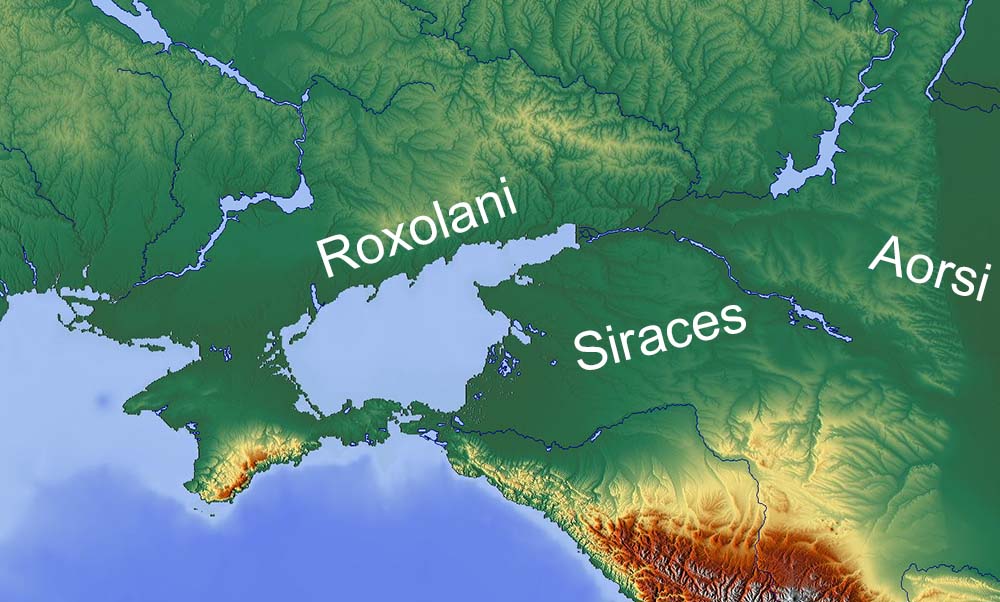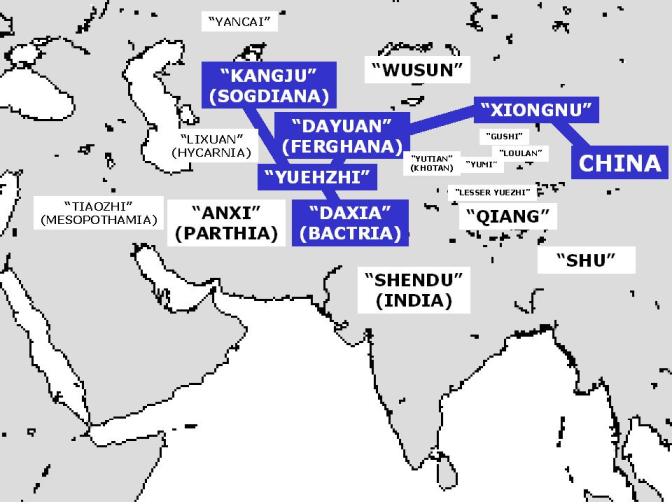|
Aorsi
The Aorsi, known in Greek sources as the Aorsoi (Ἄορσοι), were an ancient Iranian people of the Sarmatian group, who played a major role in the events of the Pontic Steppe from the 1st century BC to the 1st century AD. They are often regarded as connected to the contemporaneous Eurasian steppe state of ''Yancai'' (or ''Yentsai'') mentioned in ancient Chinese records. The Alans, first mentioned by Middle Eastern and European scholars in the 1st century AD, are regarded as successors of the Aorsi. Name The ethnonym ''Aorsi'' is generally linked to the Avestan ''auruša-'' and the Ossetic ''ūrs'' or ''ors'', meaning 'white'. The names '' Arsīyah'' and ''Arsā'', mentioned by Al-Masudi and Al-Garnati in the 10–12th century AD, may also be related. History The Aorsi and an associated tribe, the Siraces, are believed to have migrated during the late 5th century BC from Central Asia to areas north and west of the Caspian Sea. The territory of the Aorsi is believed to hav ... [...More Info...] [...Related Items...] OR: [Wikipedia] [Google] [Baidu] |
Alans
The Alans (Latin: ''Alani'') were an ancient and medieval Iranian nomadic pastoral people of the North Caucasus – generally regarded as part of the Sarmatians, and possibly related to the Massagetae. Modern historians have connected the Alans with the Central Asian Yancai of Chinese sources and with the Aorsi of Roman sources. Having migrated westwards and becoming dominant among the Sarmatians on the Pontic–Caspian steppe, the Alans are mentioned by Roman sources in the . At that time they had settled the region north of the Black Sea and frequently raided the Parthian Empire and the Caucasian provinces of the Roman Empire. From the Goths broke their power on the Pontic Steppe. Upon the Hunnic defeat of the Goths on the Pontic Steppe around , many of the Alans migrated westwards along with various Germanic tribes. They crossed the Rhine in 406CE along with the Vandals and Suebi, settling in Orléans and Valence. Around 409 CE they joined the Vandals and Suebi i ... [...More Info...] [...Related Items...] OR: [Wikipedia] [Google] [Baidu] |
Siraces
The Siraces ( gr, Sirakoi, lat, Siraci, also ''Siraceni'' and ''Seraci'' ) were a hellenized Sarmatian tribe that inhabited Sarmatians, Sarmatia Asiatica; the coast of Kuban River, Achardeus at the Black Sea north of the Caucasus Mountains, Siracena is mentioned by Tacitus as one of their settlements. They were said to be relatively small nation but with great morale. (bad link as of 20feb16, probably Brzezinski's book.) They were neighbours to the later enemy tribe of Aorsi. They migrated from the Caspian Sea to the Black Sea region. By the late 4th century, they had occupied lands between the Caucasus mountains and the Don, becoming masters of the Kuban region. They were the first Sarmatian tribe to have contact with the Hellenic groups on the coast of the Black Sea. In 310–309 BC, their king Aripharnes took part in the Bosporan Civil War and lost at the battle of the River Thatis (a tributary of the Kuban river). In the 1st century BC during the rule of Pharnaces II of Pont ... [...More Info...] [...Related Items...] OR: [Wikipedia] [Google] [Baidu] |
Sarmatians
The Sarmatians (; grc, Σαρμαται, Sarmatai; Latin: ) were a large confederation of ancient Eastern Iranian equestrian nomadic peoples of classical antiquity who dominated the Pontic steppe from about the 3rd century BC to the 4th century AD. Originating in the central parts of the Eurasian Steppe, the Sarmatians were part of the wider Scythian cultures. They started migrating westward around the fourth and third centuries BC, coming to dominate the closely related Scythians by 200 BC. At their greatest reported extent, around 100 BC, these tribes ranged from the Vistula River to the mouth of the Danube and eastward to the Volga, bordering the shores of the Black and Caspian seas as well as the Caucasus to the south. In the first century AD, the Sarmatians began encroaching upon the Roman Empire in alliance with Germanic tribes. In the third century AD, their dominance of the Pontic Steppe was broken by the Germanic Goths. With the Hunnic invasions of the fourth ... [...More Info...] [...Related Items...] OR: [Wikipedia] [Google] [Baidu] |
Geographica
The ''Geographica'' (Ancient Greek: Γεωγραφικά ''Geōgraphiká''), or ''Geography'', is an encyclopedia of geographical knowledge, consisting of 17 'books', written in Greek and attributed to Strabo, an educated citizen of the Roman Empire of Greek descent. There is a fragmentary palimpsest dating to the fifth century. The earliest manuscripts of books 1–9 date to the tenth century, with a 13th-century manuscript containing the entire text. Title of the work Strabo refers to his ''Geography'' within it by several names: * geōgraphia, "description of the earth" * chōrographia, "description of the land" * periēgēsis, "an outline" * periodos gēs, "circuit of the earth" * periodeia tēs chōrās, "circuit of the land" Apart from the "outline", two words recur, "earth" and "country." Something of a theorist, Strabo explains what he means by Geography and Chorography:It is the sea more than anything else that defines the contours of the land (''geōgraphei'') and g ... [...More Info...] [...Related Items...] OR: [Wikipedia] [Google] [Baidu] |
Camel
A camel (from: la, camelus and grc-gre, κάμηλος (''kamēlos'') from Hebrew or Phoenician: גָמָל ''gāmāl''.) is an even-toed ungulate in the genus ''Camelus'' that bears distinctive fatty deposits known as "humps" on its back. Camels have long been domesticated and, as livestock, they provide food (milk and meat) and textiles (fiber and felt from hair). Camels are working animals especially suited to their desert habitat and are a vital means of transport for passengers and cargo. There are three surviving species of camel. The one-humped dromedary makes up 94% of the world's camel population, and the two-humped Bactrian camel makes up 6%. The Wild Bactrian camel is a separate species and is now critically endangered. The word ''camel'' is also used informally in a wider sense, where the more correct term is "camelid", to include all seven species of the family Camelidae: the true camels (the above three species), along with the "New World" camelids: the lla ... [...More Info...] [...Related Items...] OR: [Wikipedia] [Google] [Baidu] |
Lake Maeotis
The Sea of Azov ( Crimean Tatar: ''Azaq deñizi''; russian: Азовское море, Azovskoye more; uk, Азовське море, Azovs'ke more) is a sea in Eastern Europe connected to the Black Sea by the narrow (about ) Strait of Kerch, and is sometimes regarded as a northern extension of the Black Sea. The sea is bounded by Russia on the east, by Ukraine on the northwest and southwest. The sea is largely affected by the inflow of the Don, Kuban, and other rivers, which bring sand, silt, and shells, which in turn form numerous bays, limans, and narrow spits. Because of these deposits, the sea bottom is relatively smooth and flat with the depth gradually increasing toward the middle. Also, due to the river inflow, water in the sea has low salinity and a high amount of biomass (such as green algae) that affects the water colour. Abundant plankton result in unusually high fish productivity. The sea shores and spits are low; they are rich in vegetation and bird colonies. Th ... [...More Info...] [...Related Items...] OR: [Wikipedia] [Google] [Baidu] |
Ancient India
According to consensus in modern genetics, anatomically modern humans first arrived on the Indian subcontinent from Africa between 73,000 and 55,000 years ago. Quote: "Y-Chromosome and Mt-DNA data support the colonization of South Asia by modern humans originating in Africa. ... Coalescence dates for most non-European populations average to between 73–55 ka." However, the earliest known human remains in South Asia date to 30,000 years ago. Settled life, which involves the transition from foraging to farming and pastoralism, began in South Asia around 7000 BCE. At the site of Mehrgarh presence can be documented of the domestication of wheat and barley, rapidly followed by that of goats, sheep, and cattle. By 4500 BCE, settled life had spread more widely, and began to gradually evolve into the Indus Valley civilisation, an early civilisation of the Old World, which was contemporaneous with Ancient Egypt and Mesopotamia. This civilisation flourished between 2500 BCE and 1 ... [...More Info...] [...Related Items...] OR: [Wikipedia] [Google] [Baidu] |
Babylonia
Babylonia (; Akkadian: , ''māt Akkadī'') was an ancient Akkadian-speaking state and cultural area based in the city of Babylon in central-southern Mesopotamia (present-day Iraq and parts of Syria). It emerged as an Amorite-ruled state c. 1894 BCE. During the reign of Hammurabi and afterwards, Babylonia was called "the country of Akkad" (''Māt Akkadī'' in Akkadian), a deliberate archaism in reference to the previous glory of the Akkadian Empire. It was often involved in rivalry with the older state of Assyria to the north and Elam to the east in Ancient Iran. Babylonia briefly became the major power in the region after Hammurabi (fl. c. 1792–1752 BCE middle chronology, or c. 1696–1654 BCE, short chronology) created a short-lived empire, succeeding the earlier Akkadian Empire, Third Dynasty of Ur, and Old Assyrian Empire. The Babylonian Empire rapidly fell apart after the death of Hammurabi and reverted to a small kingdom. Like Assyria, the Babylonian state ret ... [...More Info...] [...Related Items...] OR: [Wikipedia] [Google] [Baidu] |
Kingdom Of Armenia (antiquity)
The Kingdom of Armenia, also the Kingdom of Greater Armenia, or simply Greater Armenia ( hy, Մեծ Հայք '; la, Armenia Maior), sometimes referred to as the Armenian Empire, was a monarchy in the Ancient Near East which existed from 331 BC to 428 AD. Its history is divided into the successive reigns of three royal dynasties: Orontid (331 BC–200 BC), Artaxiad (189 BC–12 AD) and Arsacid (52–428). The root of the kingdom lies in one of the satrapies of the Achaemenid Empire of Persia called Armenia ( Satrapy of Armenia), which was formed from the territory of the Kingdom of Ararat (860 BC–590 BC) after it was conquered by the Median Empire in 590 BC. The satrapy became a kingdom in 321 BC during the reign of the Orontid dynasty after the conquest of Persia by Alexander the Great, which was then incorporated as one of the Hellenistic kingdoms of the Seleucid Empire. Under the Seleucid Empire (312–63 BC), the Armenian throne was divided in two—Armenia Maio ... [...More Info...] [...Related Items...] OR: [Wikipedia] [Google] [Baidu] |
Greeks
The Greeks or Hellenes (; el, Έλληνες, ''Éllines'' ) are an ethnic group and nation indigenous to the Eastern Mediterranean and the Black Sea regions, namely Greece, Cyprus, Albania, Italy, Turkey, Egypt, and, to a lesser extent, other countries surrounding the Mediterranean Sea. They also form a significant diaspora (), with Greek communities established around the world.. Greek colonies and communities have been historically established on the shores of the Mediterranean Sea and Black Sea, but the Greek people themselves have always been centered on the Aegean and Ionian seas, where the Greek language has been spoken since the Bronze Age.. Until the early 20th century, Greeks were distributed between the Greek peninsula, the western coast of Asia Minor, the Black Sea coast, Cappadocia in central Anatolia, Egypt, the Balkans, Cyprus, and Constantinople. Many of these regions coincided to a large extent with the borders of the Byzantine Empire of the late 11th ... [...More Info...] [...Related Items...] OR: [Wikipedia] [Google] [Baidu] |





.png)

.png)